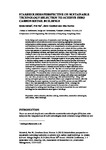Stakeholders perspective on sustainable technology selection to achieve zero carbon retail buildings
| dc.contributor.author | Zainab, S | |
| dc.contributor.author | Pan, W | |
| dc.contributor.author | Goodhew, Steve | |
| dc.contributor.author | Fuertes, Alba | |
| dc.contributor.editor | Smith SD | |
| dc.contributor.editor | Ahiaga-Dagbui DD | |
| dc.date.accessioned | 2018-08-13T09:57:56Z | |
| dc.date.available | 2018-08-13T09:57:56Z | |
| dc.date.issued | 2013-09-02 | |
| dc.identifier.isbn | 9780955239076 | |
| dc.identifier.uri | http://hdl.handle.net/10026.1/12016 | |
| dc.description | Fulltext in: http://www.arcom.ac.uk/-docs/proceedings/ar2013-1219-1229_Zainab_Pan_Goodhew_Fuertes.pdf | |
| dc.description.abstract |
In the design and construction of sustainable retail buildings, there are various stakeholders involved with the overall aim of selecting appropriate sustainable technologies to reduce energy consumption and carbon emissions. Previous studies and literature review indicate there is no comprehensive selection process to assist stakeholders. This can be classified as a complex multi-criteria decision problem due to the high number of alternatives, potential solutions and variety of stakeholders (e.g. clients, professional advisors, end-users) with multiple, often conflicting, objectives leading in turn to the slow take-up of sustainable technologies. There is a demand for a systematic and effective evaluation tool for the selection of sustainable technologies based on the needs of stakeholders. This paper is part of an on-going study to develop a decision making system to assist stakeholders in the selection process and aims to establish the decision criteria for the selection of sustainable technologies for existing retail buildings based on the clients' (retailers') perspective. The arguments are informed by a combination of literature review and an in-depth case study with a leading construction company in the UK. The data collected was both qualitative (establishing and verifying decision criteria) and quantitative (establishing weightings and priorities). Five broad decision criteria currently used by clients in the selection of sustainable technologies to achieve reductions in energy and carbon were established (i.e. cost, time, proven success of technology, risk and sustainability). Using AHP survey and expert opinions, the identified criteria were weighted and ranked, with risk (37%) being the most important, followed by cost (22%), proven success (20%) and time (12%), and sustainability (9%) the least important factor. Although the established criteria would be most relevant for the selection of sustainable technologies for existing retail buildings, it will also be beneficial for new build retail buildings and be transferable to other types of buildings. | |
| dc.format.extent | 1219-1229 | |
| dc.language.iso | en | |
| dc.publisher | Association of Researchers in Construction Management (ARCOM). | |
| dc.title | Stakeholders perspective on sustainable technology selection to achieve zero carbon retail buildings | |
| dc.type | conference | |
| dc.type | Conference Proceeding | |
| plymouth.date-start | 2013-09-02 | |
| plymouth.date-finish | 2012-09-04 | |
| plymouth.conference-name | 29th Annual ARCOM Conference | |
| plymouth.publication-status | Published | |
| plymouth.journal | Proceedings 29th Annual Association of Researchers in Construction Management Conference, ARCOM 2013 | |
| plymouth.organisational-group | /Plymouth | |
| plymouth.organisational-group | /Plymouth/Faculty of Arts, Humanities and Business | |
| plymouth.organisational-group | /Plymouth/REF 2021 Researchers by UoA | |
| plymouth.organisational-group | /Plymouth/REF 2021 Researchers by UoA/UoA13 Architecture, Built Environment and Planning | |
| plymouth.organisational-group | /Plymouth/Users by role | |
| plymouth.organisational-group | /Plymouth/Users by role/Academics | |
| dc.publisher.place | Reading UK | |
| dc.publisher.place | UK | |
| dc.rights.embargoperiod | Not known | |
| rioxxterms.licenseref.uri | http://www.rioxx.net/licenses/all-rights-reserved | |
| rioxxterms.type | Conference Paper/Proceeding/Abstract |


